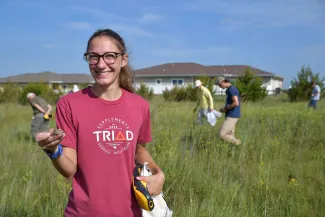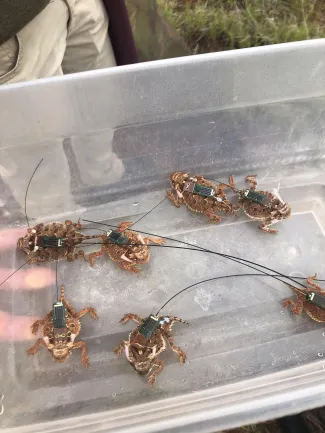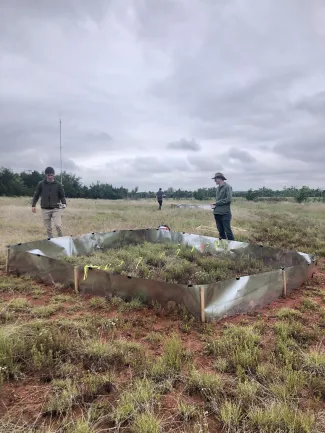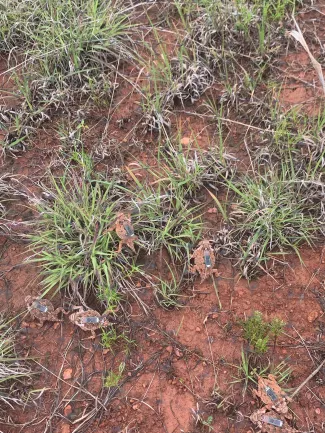The leading edge of Oklahoma’s range for Texas horned lizards may not be as fortified as more western strongholds, but that hasn’t stopped an eastern population from building a foundation of understanding for one of the state’s most beloved reptiles.
The squadron of lizards found on Tinker Air Force Base near Midwest City and Del City is a unique example of urban-dwelling “horny toads” that serves as Oklahoma’s most well-studied population. With nearly 20 years of research and monitoring behind it, this population has provided valuable insights into the daily needs and behaviors of Texas horned lizards.
The population’s downward trend, a story familiar to many lizard enthusiasts, is driving biologists to search for innovative ways to bolster the lizard’s numbers. Plans to continue managing for quality lizard habitat remain firmly in place, but Tinker’s natural resources staff also has called in reinforcements from the Sam Noble Museum at the University of Oklahoma and the Oklahoma City Zoo and Botanical Garden. Their current mission? To pioneer a trial head start program that focuses on the lizard’s most vulnerable members: its recruits.

University of Oklahoma research and field technician Katherine Stroh holds a Texas horned lizard that was recaptured during an annual sweep of a Tinker Air Force Base natural reserve as part of a long-term monitoring and research project funded by the Department of Defense.

Small “backpack” trackers allow researchers to locate individual Texas horned lizards and track their movements as they traverse the 40-acre study area. The trackers are small enough to not hamper the lizard’s movements.
“From the time that hatchlings first emerge from their nests, their chances of survival to the next year are about 33%,” said Sam Eliades, Ph.D. Candidate at the University of Oklahoma. “Survival estimates are even lower in their second year, but by the time the lizards reach the third year, when they start becoming reproductive, their chances of annual survival increase to about 47%.”
To offset this ecological shortfall and ensure as many hatchling individuals as possible survive to reproductive age, Eliades has temporarily relocated dozens of eggs and newly emerged hatchling Texas horned lizards from Tinker Air Force Base to the Oklahoma City Zoo’s behind-the-scenes “Lizard Lab.” Just 10 miles from the base, the Lizard Lab not only safeguards the growing hatchling and juvenile lizards from natural predators like raptors, snakes, raccoons and coyotes, but also offers stable overwintering conditions and abundant food during the lizard’s active season.
The trial head start procedure calls for two batches of eggs and hatchling lizards to be raised and deployed back to Tinker. The first batch consisted of lizards hatched in 2019 and the second batch from 2020 and both groups were housed at the Lizard Lab until their joint return to Tinker in the summer of 2021. Tracking devices were attached to each lizard prior to their translocation so that researchers could identify individuals when encountered in the field and so that the lizard’s survival and movements could be monitored regularly.
Upon their return to Tinker, the 1- and 2-year-old returning recruits were initially held in soft-release pens that allowed the lizards to acclimate to their surroundings while still offering protection from predators.
“Within a few minutes of putting the lizards into the soft-release pens, we saw a number of lizards find and eat native ants that were in the enclosures,” Eliades said. “They were also very capable of finding native grass clumps to hide in during the heat of the day, despite not having those structures in the Lizard Lab.”

Small, netted enclosures, or soft-release pens, were installed at Tinker Air Force Base’s study area to allow the returning Texas horned lizards to adjust to their surroundings after being held in human care for one and two years.

The returning juvenile Texas horned lizards explored their enclosures before being fully released into the study area. Six 2-year-old lizards are pictured.
The research team monitored the lizards for about five weeks before fully releasing the lizards into the nearly 40-acre natural reserve, where they have since been tracked on a weekly basis. Another batch of lizards to be raised at the OKC Zoo, which will consist of lizards hatched in 2021 and 2022, is scheduled to be returned to Tinker Air Force Base in the summer of 2023.
“We’ve learned a lot in this first stage of the trial,” Eliades said. “Not only about how to care for the lizards in the lab – it's not legal to keep them as pets, and trust me, they would make for bad pets – but we’ve also learned a lot about how to conduct future releases.
“By staging the releases with different age classes in each release, we will be able to determine how age and body size may impact survivorship in the wild. That will help us know if we should raise the lizards for two years, or if they’re better off after a one-year head start.”
Halfway in, this trial has already provided insight into the reintroduction viability of a lizard head start program.
“Prior attempts to establish new, or re-establish former, Texas horned lizard populations have proven challenging,” said Mark Howery, senior wildlife biologist for the Oklahoma Department of Wildlife Conservation. “But this trial allows us to test the feasibility of a new technique for augmenting populations or potentially moving animals between existing populations, and to assess the costs and manpower requirements of running a small head start program. If this technique proves successful, it could provide a mechanism for augmenting existing populations and potentially reduce the risk of inbreeding in small isolated populations.
“Tinker Air Force Base is the perfect location for this trial,” Howery said. “It really is a one-of-a-kind scenario that wouldn’t be possible without the initial partnerships between Tinker Air Force Base, the University of Oklahoma, and the Oklahoma City Zoo.
“The base’s natural resources office has invested so much time and energy into this unique population; the researchers at OU were already monitoring the lizards on the base’s reserves; and team members from the Oklahoma City Zoo were willing to dedicate their expertise and space for the Lizard Lab. If any of those pieces was missing, none of this would be possible.”
This project may be giving researchers with the proper permits a unique look into the lives of Texas horned lizards, but the public still plays a significant role in conservation efforts for the species. By reducing pesticide use and maintaining native vegetation, landowners can provide habitat and food for these special reptiles as well as other species of wildlife. And anyone can share recent lizard sightings with the Wildlife Department. Details like the location of the sighting, number and ages of individuals observed, and a photograph can help biologists monitor the pulse of the state’s populations.
Initial funding for this project was provided by the National Science Foundation, Sam Noble Museum at the University of Oklahoma, and the Oklahoma City Zoo and Botanical Garden. Additional support has been provided by State Wildlife Grant F20AF10405 through the Oklahoma Department of Wildlife Conservation.